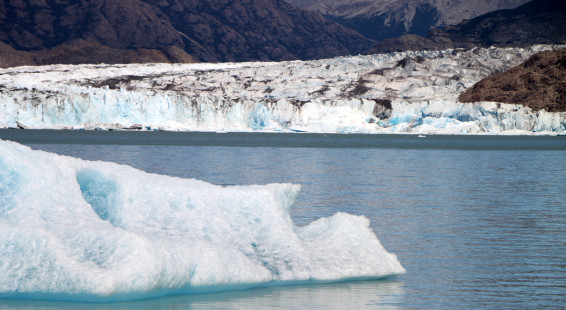
Situated close to the small Argentinean town of El Chalten is Lake Viedma, a large glacial lake. You can take a boat tour to visit the largest glacier in the Southern Patagonia Ice Field, the Viedma Glacier, from a dock on the northwestern shore of the lake, near El Chalten (which you can reach by bus from town).
The following overview photo, courtesy of NASA, will help orient you a little better. Viedma Lake is obvious, as is the Patagonian Icefield. The Viedma Glacier is at 12 o’clock in this photo (actually direction is west). The boat launch is in the little thumb at the top right of the lake at about one o’clock. El Chalten is in a non-snow covered valley near the top right corner:
The Viedma Glacier is part of Los Glaciares National Park, a UNESCO World Heritage Site, and is the source of most of the water in Lake Viedma. The Southern Patagonian Ice Field is the southern hemisphere’s second largest, covering 13,000 square kilometres (5,000 sq mi); Viedma Glacier is one of its 48 larger outlet glaciers (there are also more than 200 smaller glaciers in the Ice Field).
The boat ride to the glacier’s terminus lasts about an hour each way and our ride was on a warm sunny summer day, so it was an extremely pleasant way to enjoy the Patagonian scenery and lovely turquoise-grey water of the lake. The glacial silt gives the water a cloudy look, but it is quite pure. As you approach the 2 km (1.2 mi) wide terminus, you enter a field of hundreds of icebergs which are beautifully sculptured and very photogenic. Many of the icebergs are small, but some are larger than buildings several stories tall. The sound of ice breaking off the glacier is like the crack of a loud thunderbolt.
These icebergs, as they melt, provide the water that feeds Lake Viedma. At the far end of the lake (6 o’clock in the NASA photo) the water of Lake Viedma flows to the Atlantic via the Rio Santa Cruz.
One of the tour boat’s crew fished a piece of ice from the water, not an easy task as it is heavy and slipper. This was used to make drinks for those who wanted it. I’ve found water right off a glacier is biologically pure, but always better to be cautious when traveling.
The boat ride, glacier and iceberg experience were a very pleasant way to spend half a day. Here’s some of what we saw, more or less in order, the day of our tour of the Viedma Glacier
